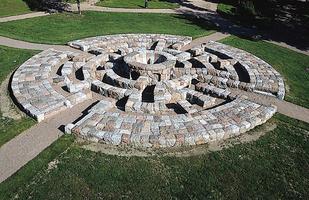| |  |
 |
 |
| artist |
Lauri Astala (1958 - )
|
|
|
 |
| sculpture |
Aurinkolabyrintti/ Sunlabyrinth |
|
|
 |
|
map | Säveltäjän puisto, Pukinmäki |
| |
 |
| |
 |
|
|
|
Lauri Astala's "Solar Labyrinth" comprises two parts; a stone labyrinth and a sun dial hidden inside a stone tower in the centre of the labyrinth, mounted on a low platform. The sundial is a semicircular bowl, with the dial, signs and markings indicating the time and date on the inside of the bowl.
"Solar Labyrinth" is the largest and most expensive single project realised by the Helsinki City Art Museum in the 1990s. The work was unveiled on Helsinki Day on June 12, 1999.
The artist has created a work whose size and massive shape forms its own miniature world in the park where it is located. Placed on a hillock, it dominates the surroundings. On the one hand, "Solar Labyrinth" is a landmark, a place for children to play, a meeting point and a place to sit down and relax. On the other, it is an environment unto itself, its dimensions, materials and details of form all carefully balanced to form an artistic whole. The work is an object carefully placed in an environment that has been moulded by the artist.
There is yet a third aspect to the "Solar Labyrinth". To find the sundial one must first clear the labyrinth, and to use the information the dial provides, that is, to tell the time, one must first master the contents of its brass table. Astala presents the viewer with challenges and tasks which pose questions about the movement of the sun and other celestial bodies, the universe and the essence of time. "Solar Labyrinth" is like a window opening to another world - once you look out of the window, you want to know more about what you see.
©
Visual Artists Association
© Helsinki City Artmuseum
WWW-production: Lasipalatsin Mediakeskus Oy,
Flammable Solutions Oy 2001
|
|
|
|

